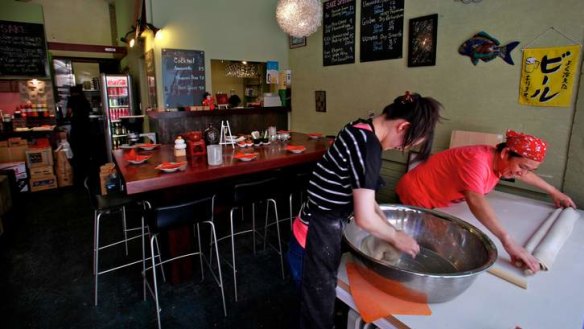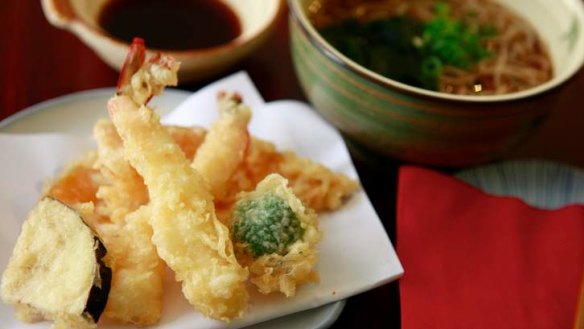Shimbashi

MOST ITEMS CARRYING A "handmade" label in Melbourne have kudos. It usually means a person has applied their particular skill to create a thing of unique quality, as opposed to a mass-made product with murky origins. Stroll down pedestrian-only Liverpool Street about 11am and you might see handmade craftsmanship in action. Shimbashi's owner-chef Taka Kumayama makes the day's soba noodles on a wooden workbench permanently set up in the window.
It's a practice that's part novelty (so, that's how you make noodles), part proof (yep, look, he really makes them) and part necessity for this 25-seat restaurant. Big bagsof wheat flour are stored under the bench and soba's essential ingredient, buckwheat, sits in bags next to the traditional stone mill used to grind it. Shimbashi's soba are 20 per cent wheat flour and 80 per cent buckwheat; the recipe Taka learnt while working with soba master Yoshi Shibazaki on the Gold Coast at one of nine restaurants spawned by Shibazaki.
At first glance, the signature soba seiro is almost austere looking - a tangle of beige noodles on an beige cross-hatch bamboo plate. But the attractiveness of the dish is a slow reveal: it sits on a black lacquered tray, with a ceramic cup of inky soy bonito dipping sauce, and a shallow dish with green highlights of sliced spring onion and a nub of wasabi. Stripped to its essentials, it's the culinary equivalent of time in the country where there's space to appreciate the natural elements. The cold-water-washed noodles hold their long, thin form; they're moist without being tacky and have a subtle wholemeal flavour.

Buckwheat is a kind of super-food, prized for its amino acids, minerals and vitamins. At meal's end, the cloudy water that cooked your noodles comes steaming in a cup; pour it into the leftover dipping sauce and drink up. It's this salubrious broth that is the foundation of Shimbashi's hot soba dishes.
There are six of these noodle-soup (kake) dishes, including an oil-beaded chicken soba bobbing with gyoza dumplings filled with chicken mince, pieces of steamed chicken, wakame and floating haloes of spring onion. Other versions include roast duck and mushroom, wild veg, and tempura - crisp-coated prawns, broccoli, eggplant and pumpkin pieces - which is also an option with the seiro (cold noodles).
There's also a decent selection of Japanese classics such as okonomiyaki; sweet, tender miso-glazed nasu dengaku; and salmon sashimi. And there's handmade minerally green tea ice-cream with sweet red-bean anko (mush) that's a thing of unique quality.
Do ... Check out the substantial sake list.
Don't ... Forget to book — the word is spreading
Dish ... Tempura seiro
Vibe ... Traditional, poky Japanese
Restaurant reviews, news and the hottest openings served to your inbox.
Sign up